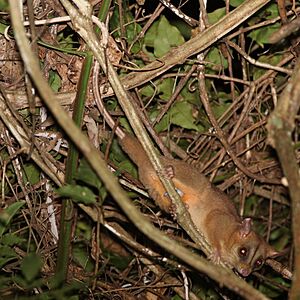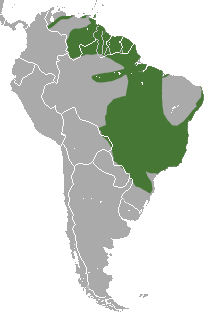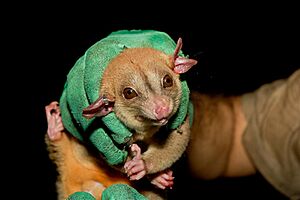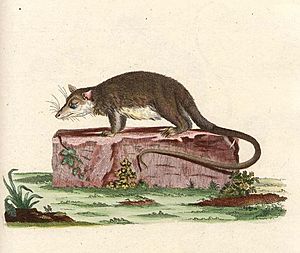Bare-tailed woolly opossum facts for kids
Quick facts for kids Bare-tailed woolly opossum |
|
|---|---|
 |
|
| Conservation status | |
| Scientific classification | |
| Genus: |
Caluromys
|
| Species: |
philander
|
| Subspecies | |
|
|
 |
|
| Range of the bare-tailed woolly opossum | |
| Synonyms | |
|
Didelphis philander Linnaeus, 1758 |
|
The bare-tailed woolly opossum (Caluromys philander) is a type of opossum found in South America. It was first described by a Swedish scientist named Carl Linnaeus in 1758. This opossum has a gray head, a coat that can be brown or gray, and an underside that is orange or gray. Its tail is partly bare, meaning it doesn't have fur on the end.
This opossum is mostly active at night, which is called nocturnal. It prefers to live alone, and you won't see much social interaction. The only times they are together are when a mother is with her young or when a male and female are mating. Bare-tailed woolly opossums build their nests inside hollow trees. A mother can have one to seven babies at a time. The babies stay inside the mother's pouch for about three months. They stop drinking milk a month after leaving the pouch. These opossums live in warm forests, including subtropical forests and rainforests. They can be found from northern Venezuela all the way to central Brazil. The IUCN (a group that checks on animals) says this opossum is of least concern, meaning it's not currently in danger.
Contents
What's in a Name?
This opossum has different names depending on the language. In Portuguese, it's called mucura-xixica. In Spanish, people call it zarigüeya lanuda parda. In the Kwaza language of Rondônia, Brazil, it's known as wakaro.
Family Tree
The bare-tailed woolly opossum is one of three types of opossums in the Caluromys group. It belongs to the Didelphidae family, which is part of the marsupial group called Didelphimorphia. The famous Swedish scientist Carl Linnaeus first described it in 1758. He called it Didelphis philander. Later, in 1900, an American scientist named Joel Asaph Allen gave it its current scientific name, Caluromys philander.
Scientists have studied how different opossums are related. They found that the bare-tailed woolly opossum is closely related to the Derby's woolly opossum and the Brown-eared woolly opossum.
There are four different types, or subspecies, of the bare-tailed woolly opossum:
- C. p. affinis: Found in Mato Grosso (Brazil) and Bolivia.
- C. p. dichurus: Lives in eastern and southeastern Brazil.
- C. p. philander: Found east of the Rio Negro in Brazil, in the Guianas, and south of the Orinoco River in Venezuela.
- C. p. trinitatis: Lives in Trinidad and north of the Orinoco River in Venezuela.
The diagram below shows how the bare-tailed woolly opossum is related to other animals.
|
|||||||||||||||||||||||||||||||||||||||||||||||||
What Does It Look Like?
The bare-tailed woolly opossum has a thick, soft, and woolly coat that can be brown or gray. Its head is gray, and its underside can be orange or gray. A special dark brown stripe runs from its nose, between its eyes, and back to its ears. There are also wider brown rings around each eye. Gray fur separates these stripes. Its ears are big and usually don't have much hair.
As its name suggests, the tail is mostly bare. The fur on its back extends onto the tail for about 5–7 centimetres (2.0–2.8 in), and after that, the tail is naked. The end of the tail is dark brown, with white and dark brown spots, and finishes with a white or yellowish-white tip.
The size of these opossums can vary. They tend to be smaller in Venezuela and larger in Suriname. Their average weight is about 170 grams (6.0 oz) in Venezuela and 250 grams (8.8 oz) in Suriname. Their body length, not including the tail, is usually between 16 and 26 centimetres (6.3 and 10.2 in). Their ears are about 3 to 3.5 centimetres (1.2 to 1.4 in) long, their tails are 25 to 36 centimetres (9.8 to 14.2 in) long, and their back feet are 3.2 to 3.9 centimetres (1.3 to 1.5 in) long.
Life in the Wild
The bare-tailed woolly opossum is nocturnal, meaning it is active mainly at night. This makes it hard to see or catch. However, it's one of the few opossums that scientists have been able to study closely. One study showed that how active males are can depend on the amount of moonlight. Males were less active when the moon was full, but females' activity didn't change much.
This opossum lives in trees, which is called arboreal. It's a very good climber. Its tail is prehensile, meaning it can grab onto things like an extra limb. This helps it move around, avoid falling, and even carry leaves to build its nests. It builds these nests with dry leaves inside hollow parts of trees.
These opossums tend to be aggressive towards each other. They might hiss, grunt, or make distress calls when they fight. They mostly live alone. The only times they interact are when a mother is with her young, or when a male and female are mating. In a primary forest in French Guiana, the average area an opossum uses, called its home range, was about 3 hectares (0.012 sq mi). The home ranges of males and females often overlapped a lot. The size of their home range depends on things like how much food is available and what the individual opossum needs.
Young and adult opossums often make a "click" sound. Like other Caluromys species, bare-tailed woolly opossums will bite if they are handled or if they need to escape from predators. Some of their predators include the jaguarundi and the margay. This opossum can also be a host for a tiny worm-like parasite called Gigantorhynchus lutzi, which lives in its intestines.
What Does It Eat?
The bare-tailed woolly opossum is an omnivore, meaning it eats both plants and animals. Its diet includes fruits, vegetables, tree gum, flowers, and nectar. It also eats small creatures like beetles, butterflies, other insects, and other small invertebrates. Sometimes, it might eat small birds and reptiles.
Scientists studied how this opossum and another animal, the kinkajou, find food. They found that both animals eat many different plants. They choose plants based on how common they are and prefer certain parts of plants at different times of the year. One interesting difference was that the kinkajou focused on plants that were spread out widely. However, the bare-tailed woolly opossum also ate plants that were less common.
Reproduction and Life Cycle
In French Guiana, female opossums can start having babies after they are one year old. Females can have up to three groups of babies, called litters, each year, unless there isn't enough food. The babies stay inside the mother for 25 days before they are born. This is the longest time for any marsupial in this group. The young opossums come out of the mother's pouch when they are three months old. They stop drinking milk when they are four months old.
A study in French Guiana showed that the babies grow slowly for the first 40 days. Then, they start to grow much faster during the next 40 days. A mother can have between one and seven babies in a litter. Newborns weigh only about 200 milligrams (0.0071 oz). After they stop drinking milk, their weight increases to about 11 grams (0.39 oz). After leaving the pouch, the young opossums stay in nests. The mother regularly visits them there to feed them.
Where It Lives and Its Future
The bare-tailed woolly opossum lives in subtropical forests, rainforests, and even in areas where forests are regrowing, called secondary forests, and on plantations. It likes places with lots of dense plants to hide in. It can also be seen high up in the canopies of trees. These opossums can live at heights of up to 1,200–1,800 metres (3,900–5,900 ft) above sea level.
Their home range stretches from northern Venezuela east to northeastern and southcentral Brazil. It also includes places like Guiana, French Guiana, Margarita Island, Trinidad, and Suriname. The IUCN has listed the bare-tailed woolly opossum as least concern. This means they believe there are many of these opossums, and they are spread out over a large area. However, their survival is still threatened by deforestation (when forests are cut down) and the loss of their natural homes.




